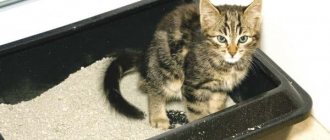When bloody bald spots appear on a pet’s body, it is difficult not to feel worried for the animal’s life. This symptom, as a rule, really indicates the presence of a disease in the cat, which can only be diagnosed with the help of a specialist. Therefore, the best thing an owner can do under such circumstances is to show the cat to a veterinarian. Persistent scabies is caused by a number of factors, from ear mites to atopic dermatitis. We will talk further about the possible reasons why a cat scratches behind its ear until it bleeds.
Cat scratching its ear
Why does a cat scratch its ear until it bleeds?
If a cat occasionally scratches its flaps, this is a preventive, hygienic procedure. But if a cat scratches its ear until it bleeds, this is a sign of malaise. Symptoms of ear diseases in an animal will be:
- The cat scratches with its paw and sometimes releases its claws.
- Shakes his head intensely, tilts his head to the side.
- Behavior is characterized by nervousness and aggressiveness.
- The pet does not allow inspection and hides.
- An unpleasant odor emanates from the ear.
The cat has eczema
Alarming symptoms
Cat ears are the real Achilles heel of these animals, since the openness of a cat's ears is an excellent excuse for parasites, water and foreign bodies to get in there. To avoid complications, it is advisable to examine your pet’s ears weekly in order to recognize an impending disease in time.
To prescribe treatment, it is necessary to identify the causes of incessant itching.
Among the manifestations indicating ear damage, the most common are the following:
- the cat makes unnatural movements with its head, shaking it as if trying to shake something out;
- the ears take on a more saturated pink or even reddish tint;
- the pet's ears become wet from the inside, purulent discharge is possible;
- an unpleasant odor emanates from the cat’s ears, which was not characteristic of her previously;
- crusts and scars appear on the surface of the ears;
- the cat compulsively scratches its ears, despite the wounds that form.
Consequences of intensive scratching
Why does he shake his head?
Sometimes a cat shakes its head to get rid of accumulated wax or water that has gotten into its ears. Such cases are normal, but should be in moderation. When a pet often tilts its head to the side and shakes it, then there is already cause for concern.
Ear mite
Parasites are a common cause of ear scabies. The cat's ear is designed in such a way that, thanks to certain glands, it is capable of self-cleaning. On the other hand, such an environment is favorable for the development of the parasite. Otodectos cynotis is a mite that causes ear scabies in cats and even dogs. A pet becomes infected with this parasite from an already sick animal. The organ becomes inflamed, our four-legged animal begins to scratch it with its paw, sometimes even releasing its claws, injuring itself. In advanced cases, there is a threat of purulent otitis media.
Ear mite
Ear abscess
Abscess is a purulent disease characterized by rapid development. An abscess develops from scratches and wounds that are not properly treated. Symptoms are: swelling of the wound site, redness of the skin, baldness of the infection site, discharge of pus. If the disorder is left to chance, this will lead to its further development, and healthy tissues will begin to suffer. The best solution would be to contact a veterinarian.
Hematoma
Unlike an abscess, a hematoma is characterized by an accumulation of blood rather than pus. Blood accumulates at the site of the bite or scratch. Small hematomas disappear on their own; treatment of larger ones requires the help of a specialist. A tumor can be identified by an elevated temperature; the wound site usually swells. Usually develops from the inside.
Infectious bacteria
Infectious bacteria can also cause ear diseases. A pet's dirty ears become an excellent breeding ground for microorganisms.
Small pests
Yeast fungus
Bacteria thrive in a humid environment. Owners often assess this disease as simple, the consequences of ear mite removal or otitis, and do not pay attention to the pet’s behavior. The reasons for this enemy are excessive bathing of the pet and high humidity in the room. The manifestation of the fungus is itching, unpleasant odor, and peeling of the skin.
Otitis
When an infection occurs, cats begin to develop otitis media. There are three types of ear inflammation: external, middle, internal. It depends on where the source of the disease is located. The disease is accompanied by fever, lethargy of the pet and loss of appetite. This is one of the most dangerous diseases, which can lead to further hearing loss or complete hearing loss.
You should not treat inflammation yourself without the supervision of a veterinarian.
Dermatitis or eczema
To identify this problem, it is necessary to conduct a full examination of the cat by a veterinarian. Dermatitis can be divided into different subtypes and is a disease of the outer layers of the skin.
Various factors cause the development of infection:
- allergy,
- injury,
- pathogenic bacteria,
- chemical exposure.
Signs of the development of dermatitis include a small red rash, severe scratching of the ear, and clearly visible reddened areas under the fur. Eczema is a type of dermatitis that is rarely an independent disease. It accompanies some pathologies, such as allergies.
Dermatitis in a cat
Diagnostic methods
If your cat is constantly scratching its ears and is very worried about other unpleasant symptoms, then you should not delay a visit to the veterinarian. Even if your pet’s ear is externally clean, but itching sensations are observed, then to be safe, it is recommended to be examined by a specialist. First, a visual examination is carried out and an additional clinical picture is clarified. If in this way it was not possible to find out why the cat’s ear itches, then a comprehensive diagnosis will be required. If otodectosis is suspected, scraping is performed with further microscopic examination. Using this diagnostic method, it is possible to identify the causative agent of ear scabies. The following manipulations are also performed to make a diagnosis:
The animal's hearing organs should be examined by a specialist during otoscopy.
- otoscopy with examination of the ear canal;
- blood and urine tests;
- laboratory test for sensitivity to antibacterial drugs.
Treatment
Of course, if your four-legged friend becomes infected, you should seek help from a specialist. But how can you fight diseases on your own after being diagnosed by a veterinarian?
At home
For each disease, the veterinarian prescribes separate drops, antiseptics or antibiotics, depending on the source of infection and the characteristics of the cat’s body. When choosing treatment at home, you must strictly follow the prescription and prescribed recommendations.
Use prescribed medications to treat wounds, ears and strengthen the animal’s immunity. Monitor his well-being, take care of a comfortable environment.
In the clinic
In advanced cases, the pet needs to stay in the clinic. With the help of surgery, hematomas and abscesses can be removed. After surgery, the animal may remain in the hospital. This is necessary to monitor his well-being and health in order to prevent complications.
Your veterinarian can treat your pet's infection and help remove parasites.
Ear check
What to do, how to help a cat depending on the problem at home
If you discover that your cat has ear problems, you can provide first aid to her at home. When otodectosis or sulfur plug occurs, it is possible to carry out all the treatment on your own.
In the first case, it is enough to buy drops at a pet store and carry out the course according to the instructions of the drug, and in the second, instill saline solution into the ear canal blocked by a plug several times a day for a week.
When treating a hematoma in an animal, the auricle is lubricated with absorbable ointments, such as Troxevasin and Troxerutin. It is unacceptable to try to open a hemorrhage yourself.
With otitis media, treatment on your own is impossible. As a last resort, it is permissible to clean the ear with a cotton swab moistened with hydrogen peroxide, followed by placing Levomekol ointment in the ear. Antibiotic injections are prescribed only by a veterinarian.
Prevention
- Keep your pet's ears clean and take care of them. Clean them once a week.
- Monitor your pet's walks. Limit contact with sick and homeless animals.
- Inspect your furry's body yourself for scratches and wounds and treat them as necessary.
- Keep your home clean. Parasites such as ear mites can live right in your home due to poor hygiene.
- Boost your cat's immunity. To do this, you need to control your pet’s diet. With a good immune system, the body itself will be able to fight certain diseases.
Keep an eye on your pet. Please note that you should not skimp on your pet’s health, because he is a full-fledged member of the family. We must be responsible for those we have tamed. It is very important to be able to understand your pet, and then you will intuitively feel his health problems. All the best!
Video from the clinic What to do if your cat scratches its ears
How to examine a cat's ears?
It would seem that this task is not at all difficult. However, some cats are quite shy, and for others this procedure is extremely unpleasant, so they may behave restlessly and cause discomfort during examination .
- Take the animal in your arms. Let it lie down for a while and calm down. You can also stroke the cat in the direction of hair growth, scratch the neck or behind the ear.
- Gently and smoothly move away the auricle to better examine its condition. It is advisable not to use bright light, because the pet may get scared and run away.
In its normal state, the shell is slightly covered with soft fluff and has a pinkish color. If no dirt or discharge is found in the ear, then the animal is absolutely healthy and can be released.
Possible reasons for a cat's close attention to his ears
If a cat scratches its ears until it bleeds, the problem may be hidden in the following disorders:
- congenital structural anomalies;
- inflammation of the inner ear;
- disruption of the endocrine glands;
- parasitic infestations;
- pathogenic microorganisms;
- allergic reaction.
Congenital anomalies of the structure, for example, too narrow an ear canal or deformation of the shell, inherent in cats of certain breeds, are rather not a cause of discomfort, but a predisposing factor to the development of various diseases.
If the functioning of the endocrine glands is disrupted, mainly in sterilized animals, blockage of the ear canal with sulfur, lipomas or benign neoplasms is observed. This causes discomfort, manifested by pain or itching.
All other disorders and diseases are characterized by specific symptoms, knowing which the owner will be able to make a preliminary diagnosis.
By what signs can you suspect something is wrong?
A healthy animal scratches its ears and periodically shakes its head - and this is completely normal behavior. It is necessary to pay close attention to the well-being of your pet if the cat is experiencing obvious discomfort. This is manifested by constant scratching, restlessness, and general nervousness of the animal. The owner's first priority is to carefully examine the pet.
Alarming symptoms:
- Peeling in the ears.
- Formation of receding hairline.
- Crusts and erosions.
- Discharge from the ear canal.
- Unpleasant smell.
- Gait disturbances.
One of the most dangerous symptoms is gait disturbance, indicating damage to the vestibular apparatus. Such a case requires urgent medical attention, especially for older animals.
Otodectosis or ear mites
Otodectes (ear mites) is a common parasitic disease caused by the Otodectes cynotis mite. Mites infect the inner surface of the cat's ear, ear canal, and even the eardrum. In advanced forms of otodectosis, parasites invade the meninges, causing disturbances in the central nervous system.
Symptoms of the disease:
- the cat shakes its head, crusts and dirt fly out of its ears;
- an abundant dark brown or black wax deposit forms in the animal’s ears (this plaque is similar in structure to instant coffee);
- lethargy, increased body temperature in the cat, and bowed head may be observed;
- in advanced stages of the disease, the eardrum bursts, and the cat develops neuralgic disorders (fits, convulsions).
Otodectosis has pronounced symptoms, but the final diagnosis can be made by a veterinarian after testing for the presence of ear mites.
Treatment for ear mites in cats
Otodectosis therapy consists of three main measures:
- mechanical cleaning of the ears;
- use of acaricidal drugs;
- strengthening the cat's immunity.
The purpose of mechanical ear cleaning is to remove mites, their eggs and waste products, remove crusts and wax deposits from the ear canal. For this procedure, you need to use disinfectant solutions - furatsilin solution or 3% hydrogen peroxide. To more effectively clean the ear from parasites, it is recommended to use an acaricidal drug, acaromectin, in combination with disinfectants.
After cleaning the cat’s ears from mites and dirt, the ear canal is treated with acaricidal drugs - acaromectin, otoferanol or stronghode. To distribute the medication evenly, gently massage the cat's ears.
To strengthen the cat’s immunity, immunomodulators and vitamin therapy are used:
- ribotan;
- immunofan;
- gamavit;
- mineral and vitamin complexes.
When treating ear mites in a cat, it is necessary to carry out a complete disinfection of the house:
- wash and treat the animal’s bed, rugs and toys with disinfectants;
- Do wet cleaning with disinfectant solutions every day.
If you have several pets, then they also need to be shown to a veterinarian and prevent the disease. After the cat is treated for otodectosis, the veterinarian conducts a repeat test for the presence of parasites. Only if the test result is negative, the cat is considered healthy.
Prevention of otodectosis
Any disease is easier to prevent than to treat. Ear mites in cats are no exception. To prevent otodectosis it is necessary:
- regularly inspect the animal’s ears and clean them if necessary;
- treat the cat with antiparasitic agents in a timely manner;
- observe the rules of hygiene and cleaning of premises;
- Provide the cat with proper nutrition and proper care.
If you find one of the symptoms of otodectosis in your ward, immediately contact your veterinarian to diagnose the disease and prescribe treatment.
Information for cat owners.
The cause of severe itching and external otitis in cats in 50% of cases is otodectosis. To treat otodectosis in cats, you can use antiparasitic ear drops , drops on the withers, or injections of an antiparasitic drug.
Antiparasitic ear drops must be instilled at least 3 times with an interval of 5-7 days (this is due to the development cycle of the tick). For example, your veterinarian may prescribe Bars Forte ear drops for cats . This drug has the widest spectrum of action against pathogens; has a therapeutic effect for otitis caused by both microbes and fungi; has an anti-inflammatory effect. According to reviews from owners , Bars ear drops for cats are indeed very effective, affordable and easy to use. However, remember, if you drop drops into dirty ears, the drug will not be able to penetrate deep into the ear canal, and accordingly, the drops may not be able to start working. This is another reason why it is better to do this procedure at a veterinary clinic for the first time. Remember that only with the correct use of Bars ear drops for cats or any other ear drops, the treatment will be effective and will not cause discomfort in the animal.
Drops on the withers have an excellent therapeutic effect. This is especially useful for animals that react negatively to ear cleaning and drops. However, these drugs are expensive.
If the lesions are severe, injections of an antiparasitic drug (ivermectin) may be required. The drug is administered subcutaneously 3 times with an interval of 10 days. This is a 100% way to get rid of ear mites. The disadvantage of this method of treatment is pain when administering the drug, and the need to visit the clinic for injections.
Attention! Otodectosis is very contagious in cats , so it must be diagnosed and treated only by specialists at a veterinary clinic, and not from photos on the Internet. The sooner you start professional treatment, the faster your pet will recover!
Modern approaches to treating the disease
Before starting treatment, it is necessary to determine exactly why the cat is shaking its head and intensively scratching its ears. The nature of therapy will directly depend on the causes of the disease, its neglect and the individual characteristics of the animal’s body. If the main etiological factor in the occurrence of a pathological condition is an infectious agent, then it is advisable to prescribe antibacterial ear drops for external use with a wide spectrum of action to the animal. Parasitic infections are treated with antiparasitic drugs, and if allergies develop, systemic medications should be used.
In most cases, when a cat scratches its ears excessively, topical treatment is sufficient. Only advanced forms of otitis need to be treated with systemic medications. Surgical treatment is performed on sick cats extremely rarely - when there is a significant narrowing of the lumen of the ear canal, abscess formation, or the need to excise part of the affected tissue due to their necrosis.
conclusions
When starting to help your pet, you should clearly know what it is sick with. The best help will depend on making an accurate diagnosis.
Help will depend on an accurate diagnosis.
You definitely need to take a close look at the animal and find out all the warning signs accompanying the main symptom.
The doctor will need this information to determine the full clinical picture. Under no circumstances should you try to help an animal yourself if you are not sure of the exact diagnosis.
Ear abscess
An abscess on a cat's ear appears as a result of trauma, injury, cut or scratch. Externally, an abscess looks like a hematoma, with only one difference - the abscess is filled with pus, not blood.
Symptoms:
- inflamed area of inflammation that is hot and soft to the touch;
- discharge and unpleasant odor from the ear;
- there may be a scab or puncture wound in the area of the tumor;
- Your cat may show symptoms of a fever, including lethargy and lack of appetite.
Treatment of ear abscess
If you notice an abscess in your cat's ear, contact your veterinarian immediately. At the first stage of the disease, he will prescribe a penicillin-novocaine blockade in combination with warm compresses from sulfonamide drugs.
At the second stage of the abscess, the veterinarian will open the inflammation and remove the pus. Then he will treat the wound with antiseptic drugs and prescribe a course of penicillin or cephalosporin antibiotics.
Information for dog owners.
Otodectosis in dogs is extremely rare. Treatment of otodectosis in dogs is no different from that described for cats, using drugs as “Bars Forte ear drops for dogs” and “Aurizon” ear drops for dogs. We discussed the first drops in detail earlier. instructions, as well as the price of Aurizon ear drops, on specialized websites. With timely detection and treatment of otodectosis, the prognosis is favorable.
And in order for your pet to always be healthy and not suffer from ear diseases, do not forget about the basic preventive measures:
- ear hygiene,
- regular treatment of your pet with antiparasitic drugs,
- balanced nutrition and preventive examination.











